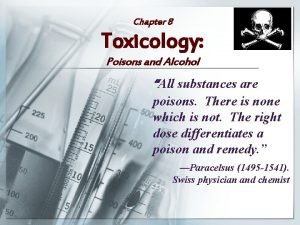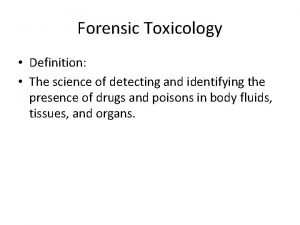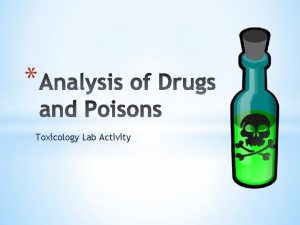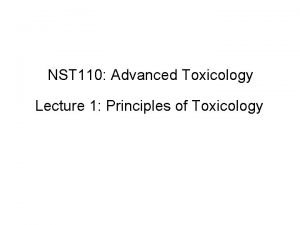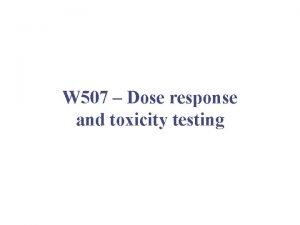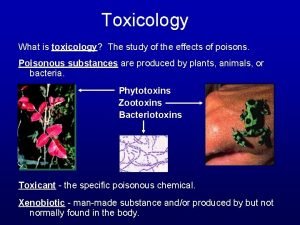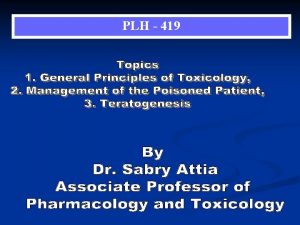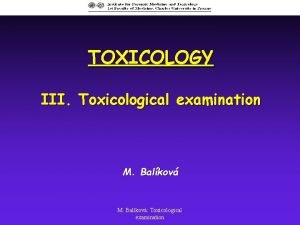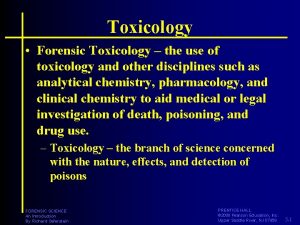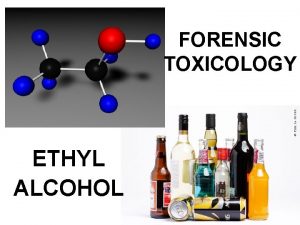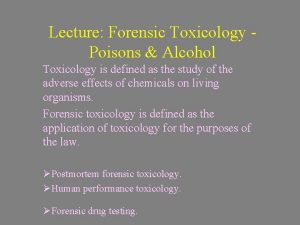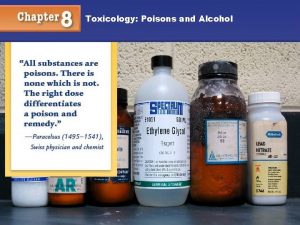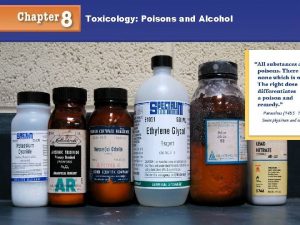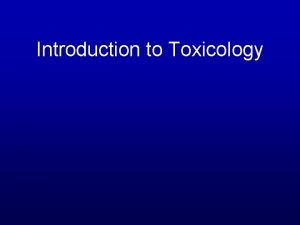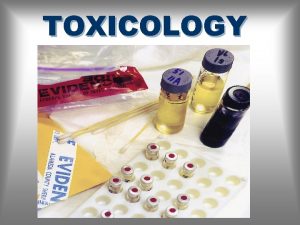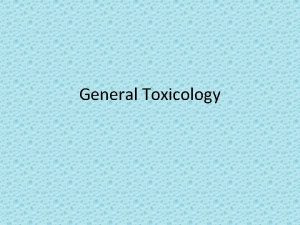Forensic Toxicology Alcohol What is Toxicology 4 Toxicological























- Slides: 23

Forensic Toxicology Alcohol

What is Toxicology? 4 Toxicological examinations involve the identification and often quantitation of drugs & toxic materials in the human body 4 The role of the forensic toxicologist is limited to matters pertaining to violations of criminal law – determination of the presence of alcohol in the body – identification of substances causing unnatural death

Toxicology of Alcohol The Fate of Alcohol in the Body

Properties of Alcohol 4 Alcohol is a general term for a family of organic compounds – commonly encountered memebers include methanol, isopropanol 4 The term alcohol will be taken to mean ethanol (ethyl alcohol)

Chemical Properties of Ethanol 4 A clear volatile liquid 4 Burns easily – oxidizes easily 4 Slight, characteristic odor 4 Is very soluble in water – miscible in all proportions

Physiological Properties of Ethanol 4 A central nervous system (CNS) depressant 4 CNS is the bodily system which is most severely affected by alcohol 4 The degree to which the CNS function is impaired is directly proportional to the concentration of alcohol in the blood

What Does the Body Do With Alcohol? 4 When an alcoholic beverage is swallowed, it is diluted by stomach juices & quickly distributed throughout the body 4 Alcohol does not require digestion before its absorption into the bloodstream – some diffuses into bloodstream directly through the stomach wall – remainder passes into the small intestine • rapidly absorbed & circulated

Alcohol Absorption 4 Alcohol is absorbed from all parts of the gastrointestinal tract largely by simple diffusion into the blood – small intestine is the most efficient region for absorption because of its large surface area 4 The rate of absorption varies according to the particular beverage & the state of the consumer’s stomach

Alcohol absorption 4 Fasting individual – 20 -25% of a dose of alcohol is absorbed from the stomach – 75 -80% is absorbed from the small intestine – peak blood alcohol concentrations occur in 0. 52. 0 hrs

Alcohol Absorption 4 Non-fasting individuals – presence of food in stomach (especially gatty foods) delays absorption • peak alcohol concentrations 1. 0 -6. 0 hrs 4 Alcohol ingested with carbonated beverages – ordinarily absorbed more rapidly than straight alcohol

Alcohol Distribution 4 Alcohol has a high affinity for water 4 Is diffused in the body in proportion to the water content of the various tissues & organs – greater concentration in blood & brain – lesser concentration in fat & muscle

Alcohol Distribution 4 Absorbed alcohol is greatly diluted by the aqueous body fluids – 1 oz. (29. 57 m. L) of 50% (100 proof) whiskey will be diluted in a man of average build, to a concentration ~2 parts per 10, 000 in the blood (0. 02%)

Blood Alcohol concentration 4 BAC is the amount of alcohol in the bloodstream measured in percentages – BAC = 0. 10% • means a person has 1 part alcohol per 1, 000 parts of blood in the body

Elimination 4 Liver eliminate ~95% of the alcohol through metabolism – oxidation via acetaldehyde & acetic acid to carbon dioxide & water 4 Remainder of eliminated through excretion in breath, urine, sweat, feces, milk & saliva 4 Rule of Thumb – 0. 5 oz (15 m. L) alcohol eliminated per hr

Blood Alcohol Concentrations 4 A set of probable average curves of BAC in an averagesize man after rapid absorption of various amounts of alcohol 4 Shows rate of BAC decline over time as a result of metabolism & excretion

Key Factors in Determining BAC 4 Sex 4 Weight 4 Amount of alcohol drank 4 Time 4 Food eaten

4 Curve a – drinking 2 oz alcohol each hr for 4 hours • BAC increase is cumulative because alcohol is consumed faster than it can be metabolized 4 Curve b – drinking 8 oz all at once

BAC’s Affect Behavior Alcohol in the bloodstream continually circulates to the brain

Some Alcohol Statistics 4 ~half of traffic injuries involve alcohol 4 ~1/3 of fatally injured passengers & pedestrians have elevated blood alcohol levels 4 ~half of homicides involve alcohol 4 1/2 to 1/3 of suicides involve alcohol 4 CDC estimates ~30, 000 unintentional injury deaths are directly attributable to alcohol

Alcohol & Driving Relative Fatality Risk(drivers in a single vehicle crash)

Alcohol in Blood vs Breath 4 The ratio of alcohol in blood to alcohol in alveoli air is 2100 to 1 4 1 m. L of blood will contain about the same amount of alcohol as 2100 m. L of breath 4 During the period of absorption, the alcohol concentration is higher in arterial blood than venous blood – breath test reflects alcohol conc. in the pulmonary artery (reflects what reaches the brain

The Breathalyzer 4 Measures the alcohol content of alveolar breath 4 Subject blows into a mouthpiece until 52. 5 m. L of alveolar breath has been collected – measures alcohol concentration of 1/40 m. L of blood 4 The alcohol in the blood is reacted with chromic acid

Breathalyzer 4 Beers’ Law – the concentration of Cr (VI) is directly proportional to the amount of 420 nm light absorbed by the sample 4 Measures the concentration of the unknown solution to the concentration of a standard sample
 Chapter 8 toxicology poisons and alcohol
Chapter 8 toxicology poisons and alcohol Toxicology types
Toxicology types History of toxicology slideshare
History of toxicology slideshare Forensic toxicology definition
Forensic toxicology definition Father of forensic toxicology
Father of forensic toxicology Forensic toxicology lab activity
Forensic toxicology lab activity Forensic toxicologist definition
Forensic toxicologist definition Forensic toxicology vocabulary
Forensic toxicology vocabulary Epoxide reaction with grignard reagent
Epoxide reaction with grignard reagent Primary alcohol oxidation
Primary alcohol oxidation Forensic psychiatry vs forensic psychology
Forensic psychiatry vs forensic psychology Thomas mocker and thomas stewart
Thomas mocker and thomas stewart Nc ocme
Nc ocme Drug identification and toxicology
Drug identification and toxicology Toxicology
Toxicology Washington state toxicology lab
Washington state toxicology lab Toxicology effects
Toxicology effects Acute toxicity
Acute toxicity Toxicology
Toxicology Toxicology is the study of
Toxicology is the study of Dumbels emt
Dumbels emt Toxicology defination
Toxicology defination Toxicology definition
Toxicology definition Hormesis toxicology
Hormesis toxicology
